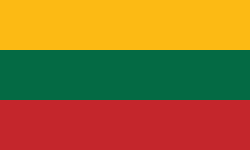Vilnius Airport (Vilnius International Airport)
Vilnius International Airport (Vilniaus oro uostas) is the airport of Vilnius, the capital of Lithuania. It is located 5.9 km south of the city center. It is the largest of the three commercial airports in Lithuania by passenger traffic. With one runway and 5 million passengers a year. Vilnius International Airport serves as a base for airBaltic, Ryanair, and Wizz Air. The airport is managed by state-owned enterprise Lithuanian Airports under the Ministry of Transport and Communications.
| IATA Code | VNO | ICAO Code | EYVI | FAA Code | |
|---|---|---|---|---|---|
| Telephone | +370 5 230 66 66 | Fax | +370 5 232 9122 | ||
| Home page | Hyperlink |
Map - Vilnius Airport (Vilnius International Airport)
Map
Country - Lithuanian_Soviet_Socialist_Republic_(1918–1919)
 |
 |
| Flag of Lithuania | |
Germany had lost World War I and signed the Compiègne Armistice on 11 November 1918. Its military forces then started retreating from the former Ober Ost territories. Two days later, the government of the Soviet Russia renounced the Treaty of Brest-Litovsk, which had assured Lithuania's independence. Soviet forces then launched a westward offensive against Estonia, Latvia, Lithuania, Poland and Ukraine in an effort to spread the global proletarian revolution and replace national independence movements with Soviet republics. Their forces followed retreating German troops and reached Lithuania by the end of December 1918.
Currency / Language
| ISO | Currency | Symbol | Significant figures |
|---|---|---|---|
| EUR | Euro | € | 2 |
| ISO | Language |
|---|---|
| LT | Lithuanian language |
| PL | Polish language |
| RU | Russian language |















